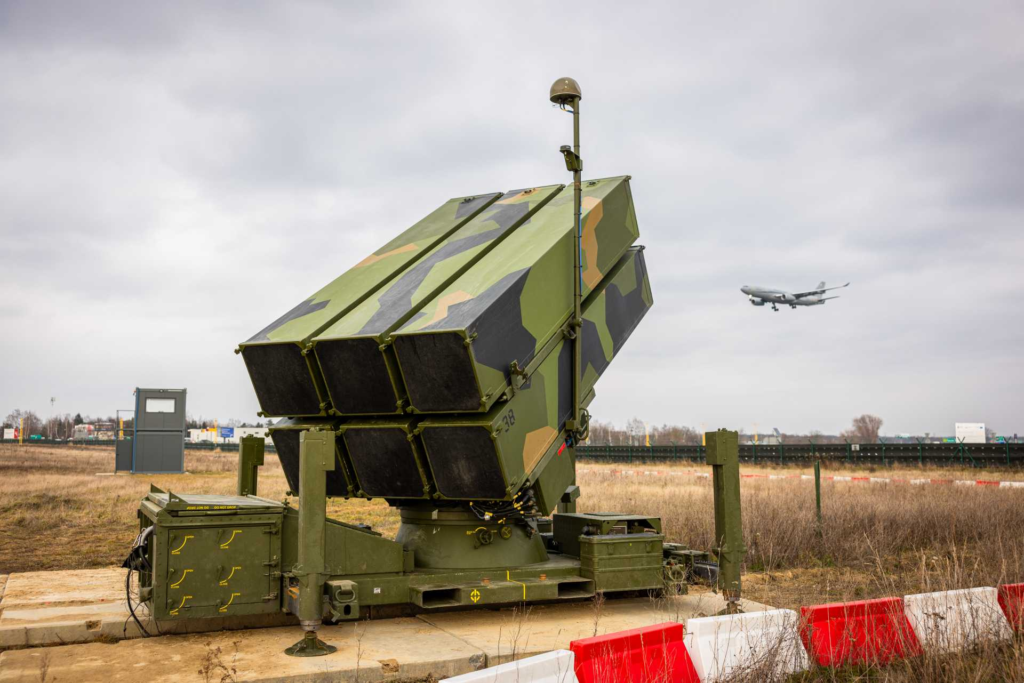According to De Morgen on June 2, 2025, Belgium plans to rebuild its ground-based air defense capabilities with the acquisition of ten Norwegian NASAMS (National Advanced Surface-to-Air Missile System) batteries, as part of a €36 billion military investment strategy led by new Defense Minister Theo Francken. This strategic planning effort is being finalized ahead of the June 2025 NATO summit in The Hague, where alliance members are expected to raise the defense spending guideline from 2 percent to 5 percent of GDP.
Follow Army Recognition on Google News at this link
By February 2025, the Norwegian Armed Forces reported that NASAMS systems in Ukraine had destroyed approximately 900 aerial targets with a hit rate of 94 percent. (Picture source: Norwegian MoD)
Belgium, which has not yet met the existing 2 percent target, has reached an internal agreement to increase defense spending. The new plan is intended to meet capability targets defined by NATO and reassure allies of Belgium’s alignment with alliance obligations. Of the total €36 billion in planned acquisitions to be contracted by 2035, €28 billion is to be effectively spent. The reintroduction of air defense systems addresses a long-standing gap since the dismantling of Belgian anti-air capabilities in the 1990s. Before that, Belgium operated a layered system including long-range Nike Hercules batteries, medium-range MIM-23 Hawk systems, short-range Roland missiles, Bofors L70 anti-aircraft guns, and Mistral MANPADS, primarily managed by the 14th Air Defence Artillery Regiment. By the late 2010s, Belgium’s national air defense relied almost entirely on F-16 fighters and the NATO Integrated Air Defense System (NATINADS), leaving the country without a real surface-to-air missile coverage.
The NASAMS procurement will consist of ten batteries, each reportedly equipped with four launchers. This system will serve to reestablish national air defense coverage and address Belgium’s current dependence on Dutch forces for the protection of its airspace. The land-based air defense investment is budgeted at €4 billion and includes not only the NASAMS systems but also long-term operational support. Belgium’s choice of NASAMS aligns it with other NATO countries that already operate the system, such as the Netherlands, Spain, Norway, and Lithuania. The system’s modular configuration enables integration within NATO’s command and control frameworks. Future joint tenders, such as the Netherlands’ planned replacement of its 40-year-old Patriot batteries, may include Belgian participation. Belgian officials have emphasized the need for coherence in system selection, noting that cooperating with the Netherlands in air defense procurement and then opting for a different system would not be operationally logical. Despite these intentions, concerns have been expressed about the limited industrial return for Belgium, particularly given the system’s Norwegian and American origins.
The NASAMS (National Advanced Surface-to-Air Missile System), developed by the Norwegian company Kongsberg Defence & Aerospace and the American Raytheon, is a modular and distributed short- to medium-range air defense system. It can engage a variety of targets, including UAVs, helicopters, cruise missiles, UCAVs, and fixed-wing aircraft. The system uses surface-launched versions of AIM-120 AMRAAM and AMRAAM-ER missiles, with the latter providing a maximum range of approximately 50 kilometers and an intercept altitude of over 35 kilometers. It also supports the AIM-9X Sidewinder. Launchers are typically towed and can carry six missiles each. Detection is conducted by AN/MPQ-64F1 Sentinel radars with a track range of up to 120 kilometers. Fire Distribution Centers (FDCs) and electro-optical sensors, such as the MSP500 and MSP600, provide command and control and can enable passive targeting. The system supports both centralized and distributed control, enabling deployment over large areas with mobile assets. NASAMS 3, the latest version, includes the ability to use Link 16 and supports interoperability with long-range systems such as the Patriot.
Ukraine’s experience with NASAMS has influenced NATO procurement decisions. The system was first delivered to Ukraine in November 2022 through a U.S.-coordinated military aid program with contributions from Norway, Canada, and Lithuania. By February 2025, the Norwegian Armed Forces reported that NASAMS systems in Ukraine had destroyed approximately 900 aerial targets with a hit rate of 94 percent. Of these, nearly 60 percent were cruise missiles, including Kh-101, Kh-555, Kalibr, Iskander-K, Kh-59, and Kh-69. One NASAMS battery, operated by a unit led by Kyrylo Peretiatko, reportedly intercepted 11 Russian cruise missiles in under two minutes on April 27, 2025. Ukrainian operators stated that their battery had neutralized over 150 aerial threats and emphasized that NASAMS functions in manual mode to ensure greater precision, with each launch typically resulting in a target hit. They also noted that AIM-120 missiles are equipped with self-destruct mechanisms, preventing unexploded warheads from remaining on the ground. Ukrainian officials rejected Russian claims about NASAMS' alleged failures, and instead pointed to the system’s continued success in high-intensity environments.
The Ukrainian Air Force reports that NASAMS has been deployed to protect key infrastructure, military airfields, and government facilities, especially during high-risk events such as the anniversary of Russia’s full-scale invasion. The system’s mobility has contributed to denying the Russian Air Force freedom of movement over Ukrainian territory, restricting Russian activity largely to missile and drone attacks. Norway confirmed the transfer of four NASAMS fire units to Ukraine in cooperation with the United States, with further contributions including additional launchers and fire direction centers ordered from Kongsberg. The total NASAMS-related contributions to Ukraine amount to at least 16 launchers and eight FDCs. In parallel, Norway deployed NASAMS batteries to Poland in December 2024 to secure the airspace above Rzeszów Airport, which is critical for military aid logistics. Norwegian F-35s also participated in this mission. The operation is scheduled to last until Easter 2025. Defense Minister Gram stated that the deployment is part of Norway’s bilateral support for Ukraine and Poland and its broader NATO obligations.
Belgian parliamentary discussions have confirmed that the NASAMS order is part of a larger NATO capability compliance effort. Prime Minister Bart De Wever stated that member states have little discretion in deciding how to meet alliance requirements, as NATO determines member responsibilities every four years. The current capability targets were agreed upon during the Vilnius summit in 2023 and include medium-range air defense. As Belgium prepares to meet these targets, internal debate continues over the distribution of defense investments. While Minister Francken obtained assurances from Washington that Belgian NASAMS and F-35 components would be assembled in Italy, some political parties such as CD&V and Les Engagés remain skeptical, particularly in light of potential U.S.-EU trade tensions under the administration of President Donald Trump. This has raised concerns about the timing and industrial return of high-value defense acquisitions, such as main battle tanks. Nonetheless, Belgian military officials maintain that neglecting national air defense obligations could carry operational and diplomatic risks, especially given Belgium’s role as NATO headquarters host country.
Although the €4 billion NASAMS package and broader air defense reinvestment align with operational requirements, their financial sustainability remains unresolved. For 2025, the government has only secured a temporary budgetary increase using one-off revenue sources and additional debt issuance. The Ministry of Defense has stated that in addition to procurement, funds will be needed to reestablish personnel structures, build infrastructure for air defense regiments, and restock depleted munitions inventories. NATO expects that Belgium’s commitment will be reflected not only in hardware acquisitions but also in permanent force readiness. The estimated annual cost of the entire defense plan is around 0.5 percent of GDP. Without structural funding reforms, Belgian officials warn that future investment cycles could face disruptions, as the current budget framework only secures increased military spending for 2025, relying heavily on one-off revenues and new public debt. Meanwhile, the Belgian Armed Forces will need to establish new training pipelines for NASAMS operators, possibly including joint instruction programs with Norway or the Netherlands. As discussions progress, the government aims to demonstrate that the acquisition of NASAMS batteries is not a one-time event but part of a durable shift in national defense policy.






You must be logged in to post a comment.